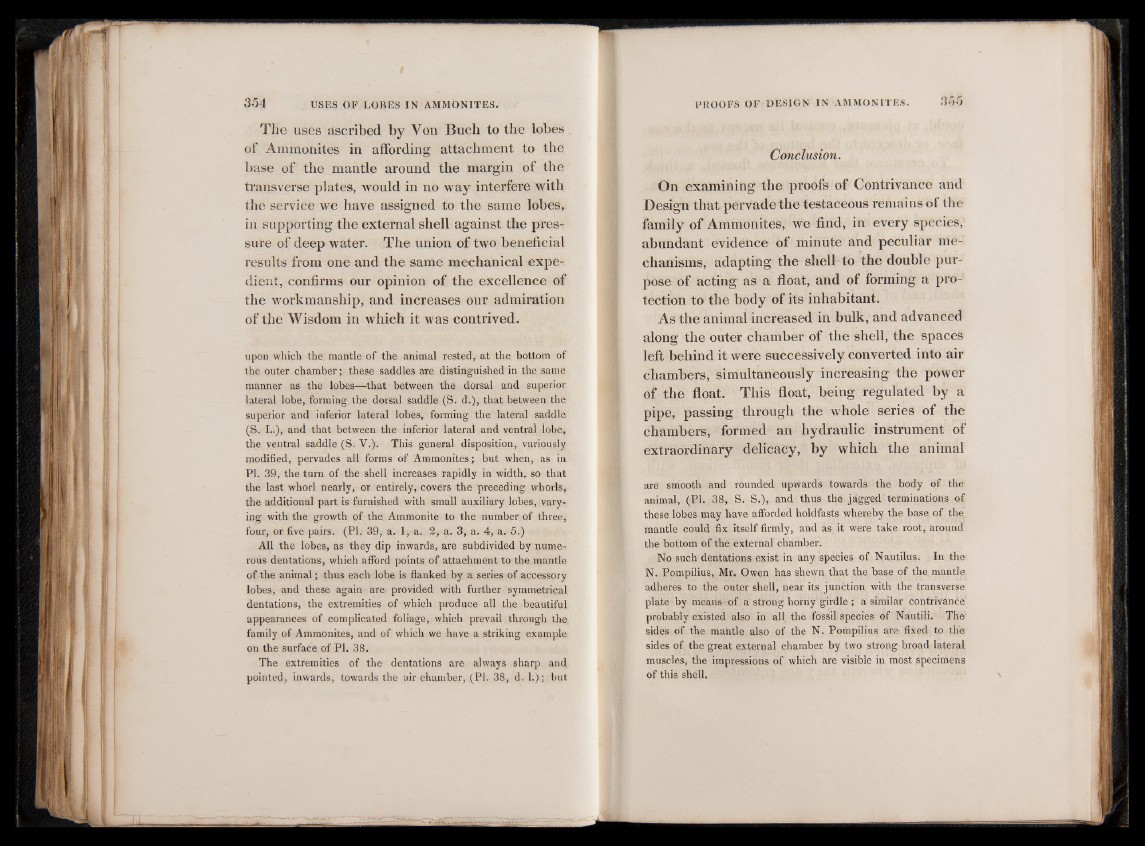
The uses ascribed by Yon Buch to the lobes
of Ammonites in affording attachment to the
base of the mantle around the margin of the
transverse plates, would in no way interfere with
the service we have assigned to the same lobes,
in supporting the external shell against the pressure
of deep water. The union of two beneficial
results from one and the same mechanical expedient,
confirms our opinion of the excellence of
the workmanship, and increases our admiration
of the Wisdom in which it was contrived.
upon which the mantle of the animal rested, at the bottom of
the outer chamber; these saddles aTe distinguished in the same
manner as the lobes—that between the dorsal and superior
lateral lobe, forming the dorsal saddle (S. d.), that between the
superior and inferior lateral lobes, forming the lateral saddle
(S. L.), and that between the inferior lateral and ventral lobe,
the ventral saddle (S. V.). This general disposition, variously
modified, pervades all forms of Ammonites; but when, as in
PI. 39, the turn of the shell increases rapidly in width, so that
the last whorl nearly, or entirely, covers the preceding whorls,
the additional part is furnished with small auxiliary lobes, varying
with the growth of the Ammonite to the number of three,
four, or five pairs. (PI. 39, a. 1, a. 2, a. 3, a. 4, a. 5.)
All the lobes, as they dip inwards, are subdivided by numerous
dentations, which afford points of attachment to the mantle
of the animal; thus each lobe is flanked by a series of accessory
lobes, and these again are provided with further symmetrical
dentations, the extremities of which produce all the beautiful
appearances of complicated foliage, which prevail through the,
family of Ammonites, and of which we have a striking example
on the surface of PI. 38.
The extremities of the dentations are always sharp and
pointed, inwards, towards the air chamber, (PI. 38, d. 1.); but
Conclusion.
On examining the proofs of Contrivance and
Design that pervade the testaceous remains of the
family of Ammonites, we find, in every species,
abundant evidence of minute and peculiar mechanisms,
adapting the shell to the double purpose
of acting as a float, and of forming a protection
to the body of its inhabitant.
As the animal increased in bulk, and advanced
along the outer chamber of the shell, the spaces
left behind it were successively converted into air
chambers, simultaneously increasing the power
of the float. This float, being regulated by a
pipe, passing through the whole series of the
chambers, formed an hydraulic instrument of
extraordinary delicacy, by which the animal
are smooth and rounded upwards towards the body of the
animal, (PI. 38, S. S.), and thus the jagged terminations of
these lobes may have afforded holdfasts whereby the base of the
mantle could fix itself firmly, and as it were take root, around
the bottom of the external chamber.
No such dentations exist in any species of Nautilus. In the
N. Pompilius, Mr. Owen has shewn that the base of the mantle
adheres to the outer shell, near its junction with the transverse
plate by means-of a strong horny girdle ; a similar Contrivance
probably existed also in all the fossil species of Nautili. The
sides of the mantle also of the N. Pompilius are fixed to the
sides of the great external chamber by two strong broad lateral
muscles, the impressions of which are visible in most specimens
of this shell.